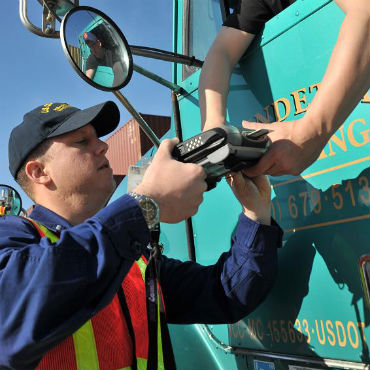Does TWIC really work?

Senators grill port security experts on whether the Transportation Worker Identification Credential program is worth the time and money.

Transportation Worker Identification Credentials are used at the Port of Baltimore and other key transit hubs, but the TWIC program remains a work in progress. (Photo: U.S. Coast Guard)
Lawmakers are raising questions about whether the Department of Homeland Security's biometric Transportation Worker Identification Credential program is on track and providing any real security value.
At a June 4 Senate Homeland Security and Governmental Affairs Committee hearing, ranking Republican Tom Coburn of Oklahoma asked the panel of federal port security officials how truck driver Jeffrey Savage used his TWIC card to enter Naval Station Norfolk in March and fatally shoot Petty Officer 2nd Class Mark Mayo. Savage had a previous manslaughter conviction when he applied for the TWIC.
TWIC applicants with a voluntary manslaughter charge applying for the credential now would initially be denied a TWIC, replied Steven Sadler, assistant administrator for intelligence and analysis at the Transportation Security Administration. That ruling could then be appealed, he said.
The card, which contains the bearer's fingerprint data and is supposed to be available to card readers at critical port facilities, has been controversial almost from the program’s inception. The rollout process, and the screening of the card-holders, remain a point of contention for the agencies using TWIC, the largest standardized biometric identification program used by the federal government across industries.
TWIC cards are issued by the TSA to transportation workers, such as port employees and truckers, who have access to potentially sensitive infrastructure, to ensure they don't pose a security threat. But readers for the cards haven't been installed at all port facilities.
The program has faced numerous delays and technical difficulties since it was launched under the Maritime Transportation Security Act of 2002. Lawmakers and Government Accountability Office officials have long voiced their frustration with the program.
"Are we doing anything with TWIC? I get it. The goal makes sense, but the concern is, how are we enhancing port security overall?" Sen. Kelly Ayotte (R-N.H.) asked during the hearing. "Are we doing better?"
"Compared to nothing," responded Stephen Caldwell, GAO's director for homeland security and justice issues. "You don’t have people getting the cards who have committed espionage against the U.S. or who have committed terrorism crimes, but that’s a pretty high bar.” He conceded, however, that the program was originally aimed at preventing a dire national security incident, not comparatively lower-level offenses.
"We had concerns about the program all along," he said, noting that the Navy no longer uses TWIC as a stand-alone credential in the wake of the Norfolk shooting.
A report presented at the hearing by Caldwell noted that while the TSA and Coast Guard have been administering the TWIC program, they have not implemented GAO's 2011 recommendations to assess weaknesses in the program.
Sadler defended the program, noting that it is the first time any government agency has tried to find out exactly who is accessing U.S. ports and to establish some kind of control over the sprawling facilities. "I’m not sure before who knew nationally who was going in and out of the ports,” Sadler said. “Every single day we have one common standard, one credential with one common background check. In some places, you once had to buy multiple credentials in the same state.”


